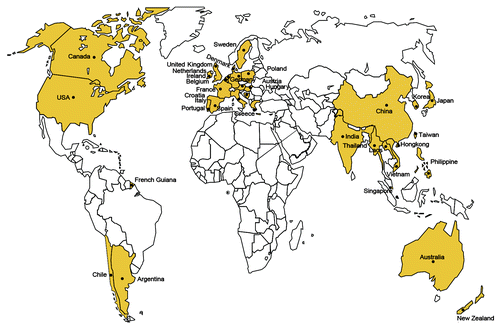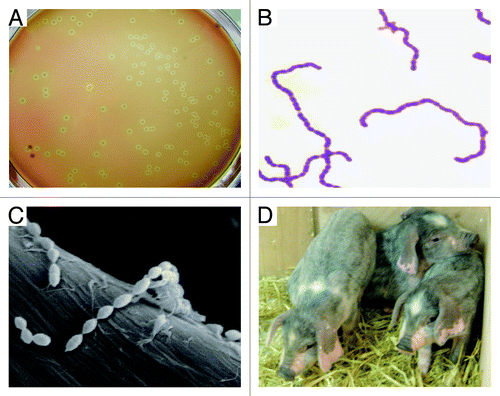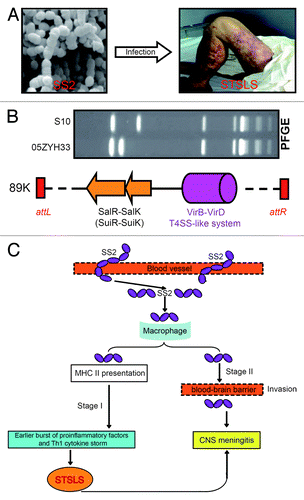Figures & data
Figure 1. Global epidemiology of human SS2 infections. Countries/regions with human cases of SS2 infections were labeled and highlighted in yellow. Adapted from references Citation2 and Citation48 with permission.

Figure 2. Circular diagram and pan-genome analyses of SS2 genome. (A) Circular diagram of representative SS2 genome. (B) Pan-genome analyses of S. suis 2 species.

Figure 3. Characterization of S. suis and its natural host piglets. (A) Colony phenotype of S. suis serotype 2 grown on THB plate with 5% sheep blood. (B) Gram staining analyses of S. suis serotype 2 grown in liquid THB media. It was adapted from reference Citation18 with permission. (C) Scanning electronic microscopic analyses of S. suis serotype 2 collected from overnight culture in THB media. (D) Phenotypic characterization of the reservoir of S. suis serotype 2, piglets maintained in backyard.

Table 1. Approaches for detection, identification and typing of Streptococcus suis
Table 2. Bacterial and host components associated with Streptococcus suis infectivity
Figure 4. Clinical syndromes, genetic basis and working model for streptococcal toxic shock-like syndrome (STSLS) caused by S. suis 2. (A) Clinical visualization of a representative SS2-infected patient with streptococcal toxic shock-like syndrome. It clearly shows purpura and gangrenous changes on this patient’s legs. Partially adapted from reference Citation9 with permission. (B) Genetic evidence that 89K pathogenicity island carries elements associated with bacterial virulence and the clinical consequence of streptococcal toxic shock-like syndrome. PFGE assay reveals Chinese epidemic strain 05ZYH33 is distinct from the international strain S10.Citation4 The two genetic elements of the transposable 89K pathogenicity islandCitation23,Citation28 have been functionally defined: one is SalK-SalR (renamed as SuiK-SuiRCitation151) TCS with requirement for full virulence,Citation27 and other is VirD4-VirB4 T4SS-like system associated with clinical manifestation of STSLS in mouse model.Citation160 (C) The proposed model of the two-stage hypothesis for STSLS. SS2 gets into blood vessels in stage I and results in an early burst of proinflammatory factors and Th1 cytokine storms. Such kind of inflammatory super-responses lead to STSLS with death as early as 13 h after SS2 infection. In stage II (i.e., several days post-infection), SS2 might use virulence factors like suilysin to cause disease, particularly meningitis.Citation94 CNS, central nervous system. Integrated and modified from references Citation4, Citation23, Citation27, Citation28, Citation94, and Citation160 with permission.

